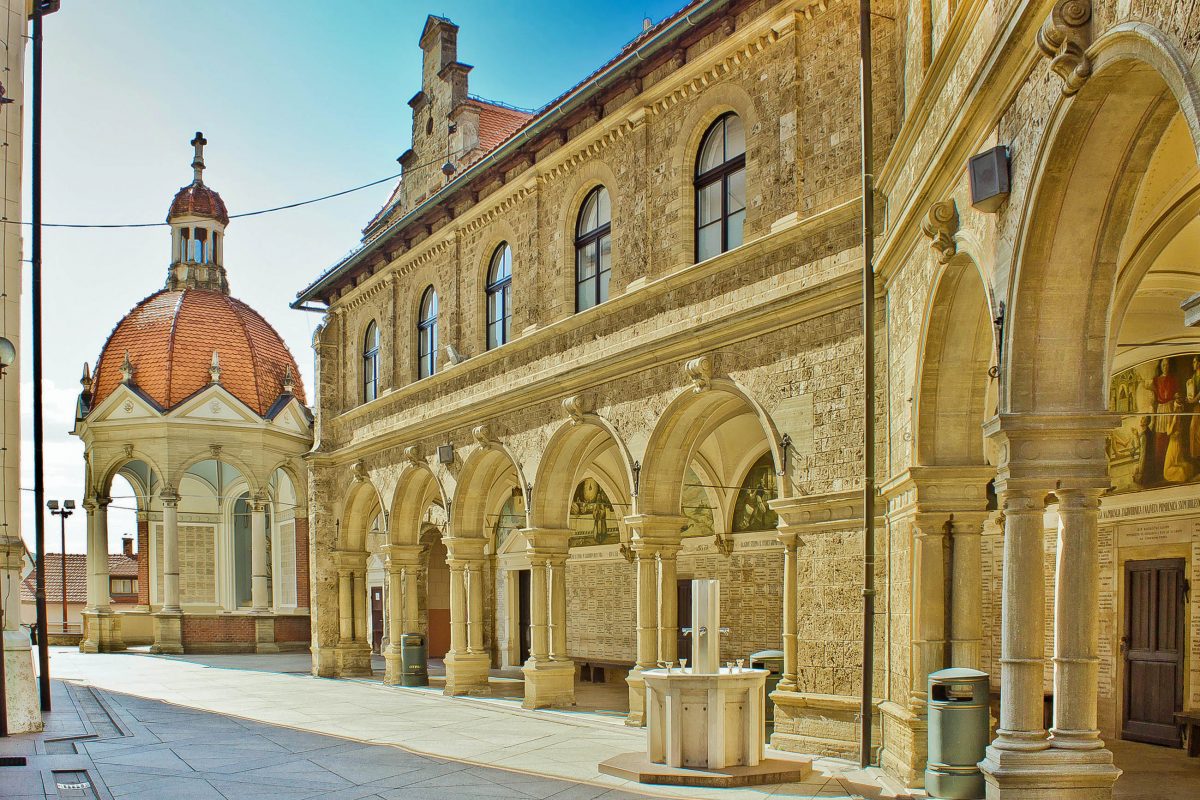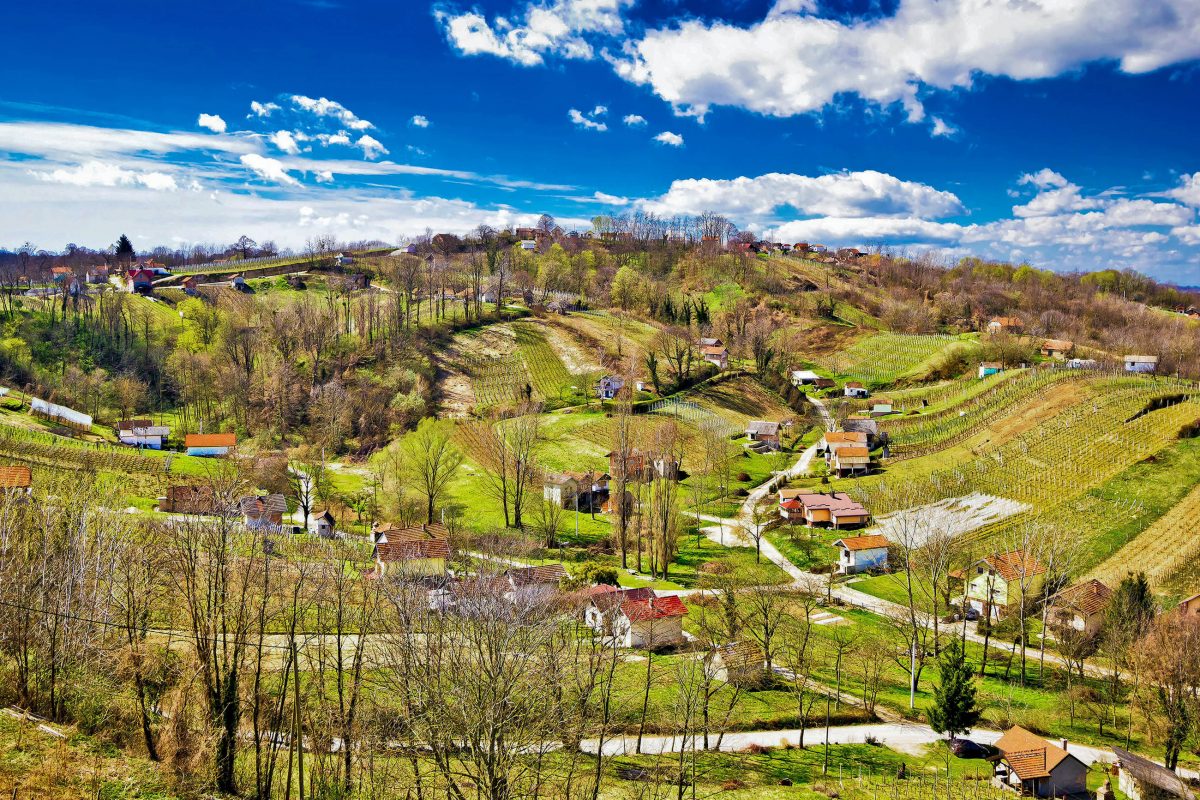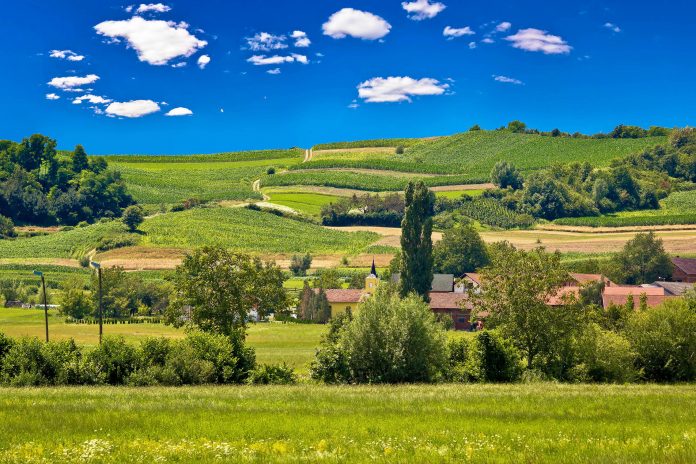Das idyllische Zagorje, das „Hinterland“ Kroatiens, scheint mit seinen stillen Dörfern teils aus dem vorigen Jahrhundert zu sein, beeindruckt aber auch mit prächtigen Schlössern und Burgen und lädt in mehreren Thermalbädern zum Entspannen ein.
Ganz im Norden von Kroatien sorgt die herrliche Landschaft Zagorje für fantastische Möglichkeiten für Outdoor- und Aktivurlaub. Das von sanften Hügeln und kleinen Dörfern geprägte „Land hinter den Bergen“ erstreckt sich nördlich der Hauptstadt Zagreb vom Medvednica-Gebirge bis zur slowenischen Grenze.
Inhaltsverzeichnis
BILDER: Zagorje
Da es auch in Slowenien und Dalmatien („dalmatinska zagora“) einen als Zagorje bezeichneten Landstrich gibt, ist in Kroatien auch oft von „Hrvatsko Zagorje“ die Rede („kroatisches Land hinter den Bergen“).
Sehenswürdigkeiten des Zagorje
Die üppige Natur des Zagorje ist von den Massen kroatischer Urlauber bisher noch verschont geblieben und bietet neben Outdoor-Aktivitäten, wie Wandern, Radeln oder Reiten, auch kulturelle Sehenswürdigkeiten für jeden Geschmack. Vor allem im Mittelalter entstanden viele Burgen und Schlösser im Zagorje, die heute lohnende Ausflugsziele darstellen.
Varaždin – charmante Barockstadt
Kroatiens ehemalige Hauptstadt Varaždin gilt mit knapp 50.000 Einwohnern als touristisches, wirtschaftliches und kulturelles Zentrum im nördlichen Kroatien. Berühmt durch ein Schlagerlied aus der „Csardasfürstin“ von Emerich Kálman ist die Barockstadt heute für ihre eindrucksvolle Festung, ihre gut erhaltene Altstadt und den malerischen Friedhof im Stile eines englischen Landschaftsgartens bekannt.
BILDER: Barockstadt Varaždin
Krapina – kajkavische Hochburg
Krapina ist neben Varaždin der zweite Hauptort des Zagorje und auch gleichzeitig Hochburg der kajkavischen Kultur. Dialekt, Traditionen und Folklore dieses Kulturzweigs werden hier nach wie vor gelebt und beim jährlichen Festival der kajkavischen Kultur auch gefeiert.
Dass das Zagorje bereits in der Steinzeit bewohnt war, zeigte im 19. Jahrhundert der bislang umfangreichste archäologische Fund von hunderttausend Jahre alten Überresten von Neandertalern. Den Urzeitmenschen ist in Krapina ein eigenes Museum gewidmet, welches bereits mit zahlreichen internationalen Preisen ausgezeichnet wurde.
Neben dem Neandertaler-Museum sind auch das Franziskanerkloster aus dem 17. Jahrhundert und die barocke Wallfahrtsstätte der Mutter Gottes aus Jerusalem historisch bedeutend.
Trakoščan See und Schloss

Das märchenhafte Trakoščan Schloss wird oft als schönstes Schloss Kroatiens bezeichnet und zählt mit rund 40.000 Besuchern jährlich zu den meistbesuchten Schlössern des Landes. Schloss Trakoščan wurde im 13. Jahrhundert erbaut und erhielt sein heutiges Erscheinungsbild im 19. Jahrhundert.
Kaiser Maximilian II. schenkte das Anwesen im Jahr 1584 Juraj Drašković von Trakošćan, in dessen Familie das Schloss bis zur Machtergreifung durch die Kommunisten blieb.
Das malerische Anwesen, umgeben von einem parkähnlichen Wald nahe am künstlich angelegten Trakoščan See, ist heute ein beliebtes Fotomotiv und Ausflugsziel. Innerhalb seiner schneeweißen Mauern präsentiert es historisches Mobiliar, Waffen, Fotos, Bücher und Gemälde.
Mit einer Wanderung um den See oder einer Bootstour auf den stillen Fluten und dem anschließend Besuch im Schlossmuseum lassen sich Aktiv- und Kultururlaub in Kroatien also perfekt kombinieren.
Burg Veliki Tabor

Die trutzige Burg Veliki Tabor in der Nähe von Desinić zählt zu den besterhaltenen mittelalterlichen Burgen Kroatiens. Das Bollwerk mit den gewaltigen Rundtürmen wurde im 15. Jahrhundert zur Verteidigung gegen die Türken errichtet. Der heutige Bau ist der Familie Rattkay zu verdanken und stammt aus dem 16. Jahrhundert, Teile der Burg gehen aber sogar auf das 12. Jahrhundert zurück.
Heute gehört Veliki Tabor dem kroatischen Staat, der die Burg als Sehenswürdigkeit von Zagorje betreut. Die eindrucksvolle Burg kann auch von innen besichtigt werden und offenbart den Besuchern einen 31m tiefen Brunnen, die Burgkapelle und den (ehemaligen) Weinkeller. Außerdem beherbergt es ein historisches Museum, in dem Waffen, Gemälde, Töpferwaren, historische Arzneien und die Rattkay-Familie präsentiert werden.
Wallfahrts-Basilika Marija Bistrica

In der Basilika der Muttergottes von Bistrica befindet sich eine Marienstatue aus dem 15. Jahrhundert, der zahlreiche dokumentierte Wunderheilungen zugesprochen werden. Jedes Jahr wird die Basilika Marija Bistrica von rund 800.000 Pilgern besucht. Ihre Dankbarkeit ist in weißen Marmorplatten um die gesamte Kirche herum verewigt.
Kumrovec
Richtig geschichtsträchtig wird es in Kumrovec. Das kleine Dorf an der Grenze zu Slowenien beherbergt eine ethnographische Sammlung, gilt aber an sich schon als größtes Open-Air-Museum Kroatiens. Wohnstil, Kultur und traditionelles Handwerk laufen in Kumrovec heute immer noch ab wie im Kroatien um 1900.
Kumrovec ist außerdem der Geburtsort des ehemaligen jugoslawischen Präsidenten Tito, dessen Geburtshaus besichtigt werden kann. Am Rand des Dorfes erinnert ein Obelisk an Antun Mihanović, der 1835 die Nationalhymne Kroatiens komponierte.
Klanjec
Apropos Antun Mihanović, dieser erblickte das Licht der Welt in Klanjec, ebenso einige andere prominente Persönlichkeiten, darunter auch der Bildhauer Antun Augustincic, dessen Werke in einer Galerie im Ort ausgestellt sind.
Im Franziskanerkloster und der Kirche aus dem 17. Jahrhundert sind neben wertvollen Kirchenschätzen einige Sarkophage der Adelsfamilie Erdödy zu sehen, deren Palast übrigens in Varaždin zu bewundern ist.
Gornja Stubica
In Gornja Stubica wird in einem Museum der Hergang des Bauernaufstandes von 1573 unter Matija Gubec nachvollzogen. Das Museum ist im Schloss Oršić, einem barocken Herrenhaus untergebracht, an dessen Stelle früher eine mittelalterliche Burg stand. Im Juni ist es mit seinem herrlichen Garten das Zentrum von Ritterspielen. Im Garten der Pfarrkirche steht übrigens eine 400 Jahre alte Linde, die als Naturdenkmal geschützt ist.
Erholungsurlaub im Zagorje

Neben Sightseeing und Outdoor-Aktivitäten kommt auch die Entspannung im Zagorje nicht zu kurz. Erstens erwecken zwischen den sanften Hügeln des Zagorje viele Ortschaften den Eindruck, die Zeit wäre stehen geblieben. Stress und Hektik sind Fremdwörter.
Zweitens sorgen mehrere Thermalquellen für sprudelndes Heilwasser in der Region von Zagorje, aus dem so manches Kurbad hervorgegangen ist. Zu den beliebtesten gehören die Thermen Krapinske Toplice, Stubičke Toplice und Tuheljske Toplice. Letztere ist vor allem für Familien ideal.
Küche von Zagorje
Auch die Kulinarik von Zagorje kann als Sehenswürdigkeit für sich bezeichnet werden. Gemeinsam mit lokalen Spitzenweinen sorgen vor allem die Zagorjer-Suppe, die regionalen Käse-Teigtaschen und die verführerischen Honigkuchen für kulinarische Genüsse.
Weiterführende Links:
Offizielle Website des Zagorje
Offizielle Website der Therme Tuhelj
Offizielle Tourismus-Website von Varaždin
Offizielle Website von Krapina
Offizielle Website des Schlosses Trakoscan
Offizielle Website der Burg Veliki Tabor




